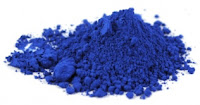 These days, Pantone and Dutch Boy make it possible to browse an endless supply of color. But centuries ago, if you wanted a brilliant shade of lapis lazuli blue, you may have had to trek through Afghanistan scouting minerals.
These days, Pantone and Dutch Boy make it possible to browse an endless supply of color. But centuries ago, if you wanted a brilliant shade of lapis lazuli blue, you may have had to trek through Afghanistan scouting minerals. Edward Forbes, former historian and director of the Fogg Art Museum at Harvard University traveled the world world collecting pigments—accumulating over 2,500 different specimens now stored at Harvard University.
 Forbes used the pigments to authenticate classic paintings. In 2007, it was actually pigment analysis that proved a "rediscovered" Jackson
Pollock painting was in fact a fake—a specific red color used in it wasn't manufactured until 20
years after the artist's death.
Forbes used the pigments to authenticate classic paintings. In 2007, it was actually pigment analysis that proved a "rediscovered" Jackson
Pollock painting was in fact a fake—a specific red color used in it wasn't manufactured until 20
years after the artist's death.So where does color come from if you aren't calculating CMYK values on a laptop? Here's a few of my favorites from Forbe's Harvard Library:
Annatto – The lipstick plant—a small tree, native to
Central and South America—produces this natural orange dye. Seeds
from the plant are contained in a pod surrounded with a bright red pulp.
Annatto is used to color butter, cheese, and cosmetics.
Mummy Brown – People would harvest mummies from Egypt and then extract the brown resin material that was on the wrappings around the bodies.
Cochineal – Red dye derived from squashed beetles, and it's used in cosmetics and food.






No comments :
Post a Comment